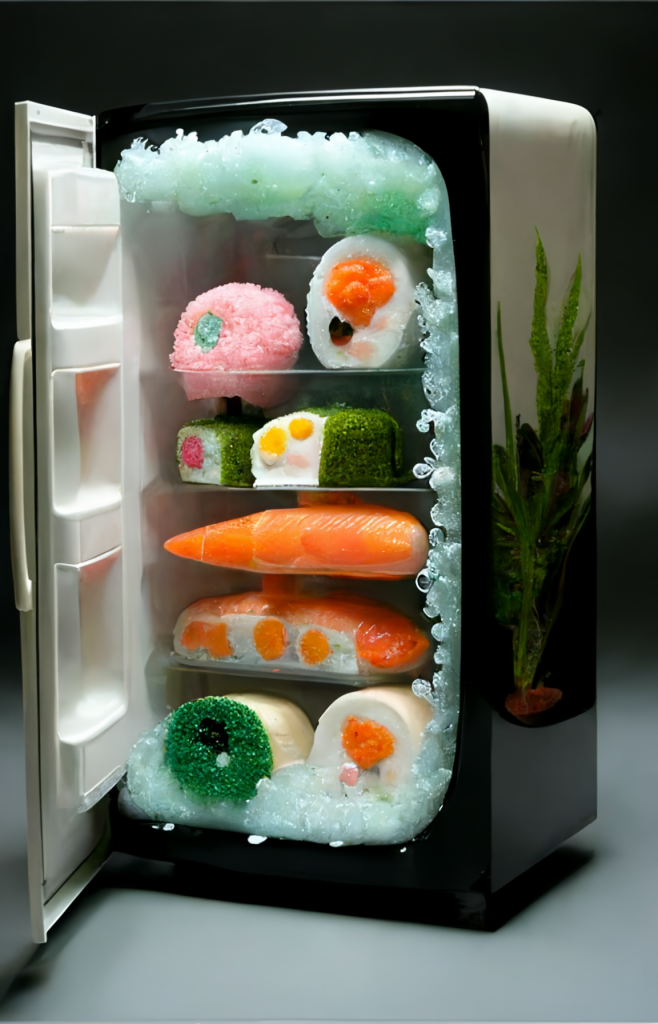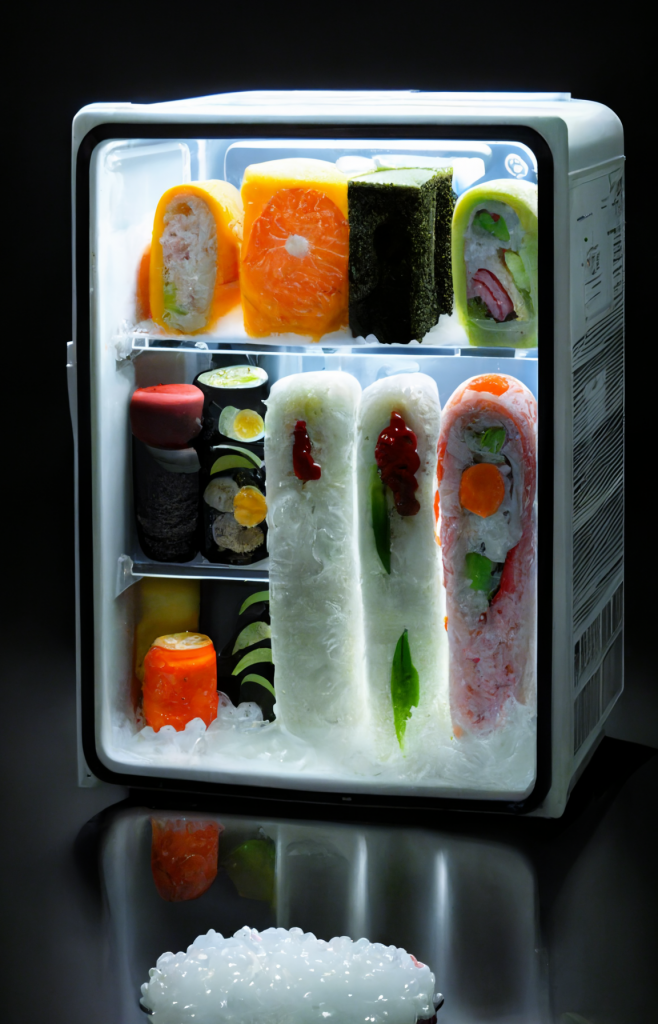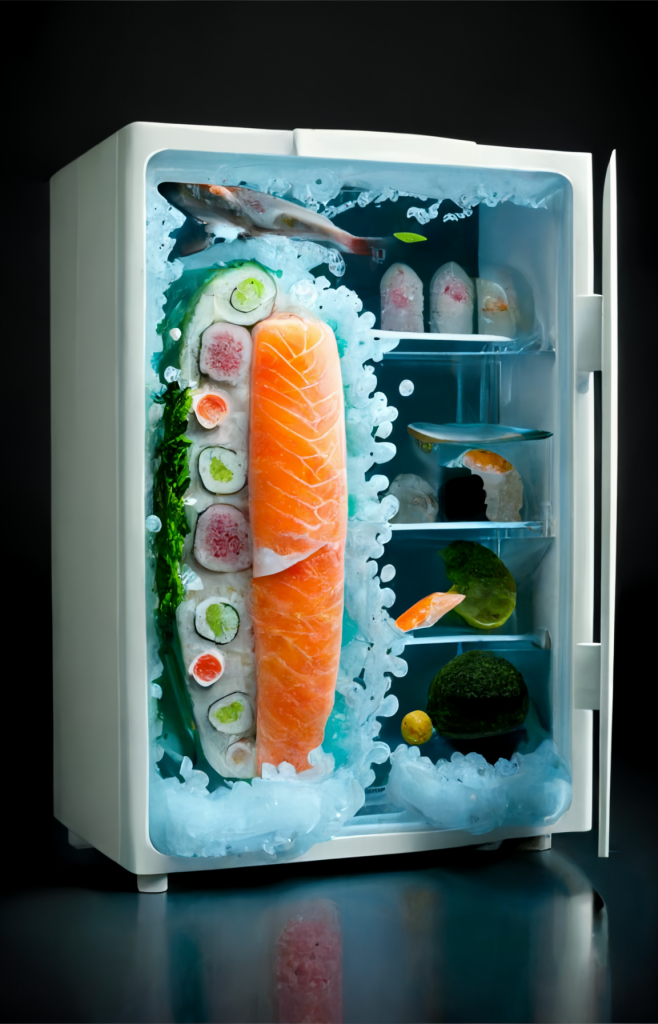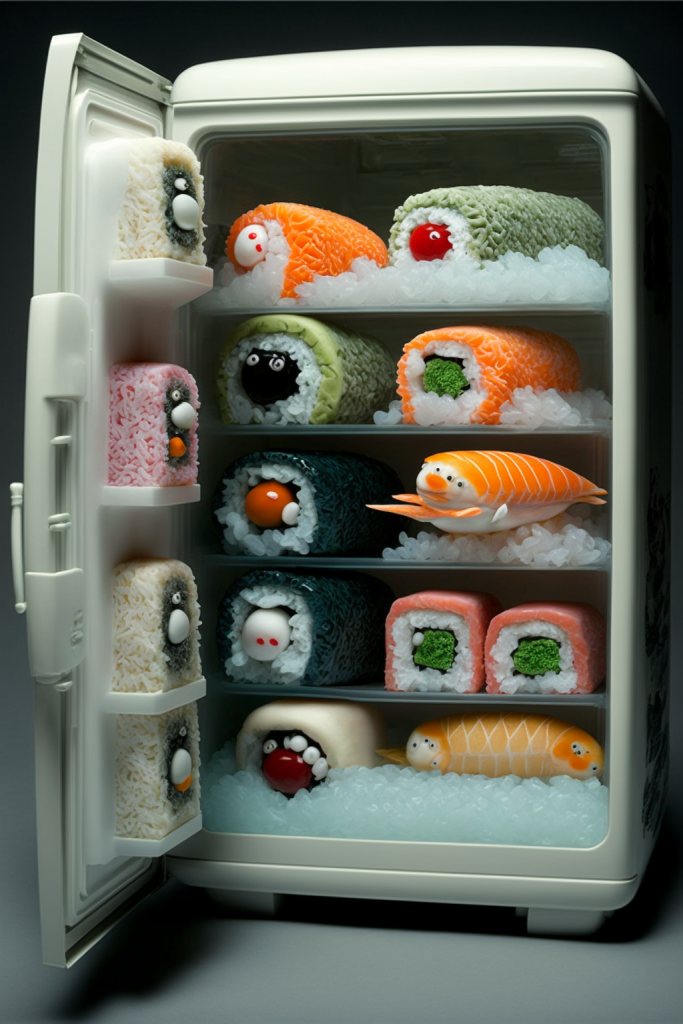Are you a sushi lover? The answer is most likely yes, unless you haven’t had the chance to experience the delicious world of sushi yet. Have you ever looked up for answers to this question ‘How long does sushi last?’, only to find unclear and confusing shelf life advice? Well, you’re in luck! In this post, we focus on the ultimate guide to sushi shelf life – so you can enjoy sushi without worrying about wasting your favorite sushi rolls.
Learn how to store, freeze, and determine the sushi expiration date – so you can indulge in fresh and tasty sushi at home anytime you want! So, let’s get started and answer the question – How Long Does Sushi Last?
Table of Contents
Quick Response to Key Question
Sushi that has been prepared properly can generally last for up to two days in the refrigerator if stored correctly. For optimal safety and freshness, consume your sushi within one day of preparation.
How Long is Fresh Sushi Good For?

Fresh sushi is a popular meal choice among those with an adventurous palate. In general, depending on the type and ingredients used to make the sushi, fresh sushi can last anywhere from one day to up to three days if properly stored in the refrigerator.
Sushi connoisseurs may argue that freshly prepared sushi is best enjoyed within 24 hours of preparation as this ensures the highest quality in terms of flavor and texture. Others may be comfortable pushing the boundaries of that timeline and will eat their sushi within two or three days – even if it has not been refrigerated. However, there are potential health risks associated with consuming raw fish (or other seafood) past the point which it is healthy to consume without fear of foodborne illnesses. To avoid these risks, fresh sushi should not be consumed beyond 3 days post-preparation.
All that said, for both safety and quality purposes, it’s always best practice to eat your fresh sushi within 24 hours of its preparation as long as it has been safely stored in an air-tight container in a refrigerator maintained at 40°F or below.
Now that we’ve looked at how long fresh sushi can last, let’s explore temperature guidelines for keeping sushi fresh and safe to consume.
Temperature Guidelines for Keeping Sushi Fresh
Temperature is one of the key factors that determines how long sushi will last. Sushi should be refrigerated immediately after it is prepared. Raw fish can last up to three days when stored in the refrigerator, while cooked fish can last up to four days. Some sushi chefs use an ice box and fill it with either cold gelatin or frozen water bottles with a thermometer set at a temperature of 39°F (4°C). This type of setup helps ensure that the sushi remains under a lower temperature during storage and transportation.
The debate over the ideal temperature for sushi storage arises from the fact that different types of sushi require different temperatures. For example, many people believe that higher quality sushi should remain at a slightly warmer temperature than more ordinary restaurant fare. This is because higher quality seafood needs to be held at a higher temperature to preserve its texture and flavor. On the other hand, restaurants and sushi bars need their food to stay consistent and not deteriorate too quickly in the fridge, so they store their sushi closer to 39°F (4°C) and avoid fluctuating temperatures.
Both approaches are valid, but how you store your own sushi depends on how soon you plan to eat it. If you intend to consume it within two or three days, then storing your sushi at 39°F (4°C) will generally be safe and fresh enough for consumption. However, if you want your seafood to stay as close as possible to its original texture, then slightly warmer temperatures may be ideal. Ultimately, finding the best storage solution for your own individual preferences will come with experimentation and practice.
Given the importance of temperature for keeping sushi at peak freshness, it’s important that when storing and transporting it you take all necessary precautions to keep it cool. To learn more about ensuring top quality and preservation of your sushi, read on to the next section about “Quality and Preservation of Sushi”.
Quality and Preservation of Sushi

When discussing the shelf life and storage of sushi, it is important to consider the quality and preservation of sushi. As with any food item that contains raw fish, the primary concern is foodborne illnesses caused by bacteria growth. Bacteria grows best in moist environments at temperatures between 40°F and 140°F (4°C – 60°C). Therefore, these temperature ranges should be avoided when storing sushi. Additionally, Japanese sushi chefs take great care to make sure their sushi has the highest quality and extends the greater product life by minimizing cross-contamination and using high-grade ingredients.
When deciding how to store sushi, there are two schools of thought: some people believe that freezing sushi will extend its shelf life without sacrificing taste or texture, while others argue that this process can damage the flavor and texture and recommend avoiding freezing altogether. If a person decides to freeze their sushi, it must be done properly as improper storage could contaminate the sushi. When considering whether to freeze sushi, it’s important to keep in mind that after defrosting there may be some texture changes in any side dishes due to the changes from the frozen environment.
It’s also important that oxygen levels are controlled when storing sushi. Too little oxygen can cause anaerobic bacteria to form which could potentially lead to foodborne illness and other health risks; too much oxygen can oxidize fats and accelerate spoilage in fragile ingredients used in many types of sushi such as avocado and smoked salmon. Therefore, it is important to maintain moderate levels of oxygen when storing sushi for maximum shelf life.
To conclude, understanding how quality and preservation can help maximize nutrition as well as prolong shelf life is integral for safely consuming delicious sushi. In the following section we’ll discuss in more detail how balanced oxygen levels can help increase shelf life without sacrificing flavor or texture.

Oxygen Levels
When considering the shelf life of sushi, oxygen levels are an important factor to keep in mind. Oxygen helps promote microbial growth in food and can cause spoilage and pose safety risks if left unchecked. That’s why it’s important to monitor oxygen levels when storing sushi for longer periods of time.
A lot of debate has surrounded the oxygen levels within closed containers that store sushi. Some experts argue that the lower the oxygen levels, the higher the likelihood that sushi will stay safe. This could be achieved by using highly efficient, hermetically sealed lids to reduce air infiltration or additives like carbon dioxide that absorb oxygen, as well as cold temperatures that slow down any microbial growth. Others suggest a container with more natural ventilation is more conducive to a better overall quality and taste of sushi since these ingredients depend on adequate oxygen to thrive at their best.
To ensure freshness and safety when storing sushi, it’s recommended to check either option depending on individual preferences, as long as appropriate oxygen levels are maintained and monitored at all times.
With that in mind, safely storing sushi should be done in the right way to maximize its shelf life so let’s move onto discussing this next.
Safely Storing Sushi
When it comes to keeping sushi fresh, a big part of the equation revolves around proper storage. Knowing how to store sushi properly can go a long way in preserving both the flavor and quality of this beloved delicacy.
First and foremost, it’s important to remember that any type of sashimi or sushi should be refrigerated at 40°F or below as soon as possible after purchase. So if you’re planning on eating it within three days, don’t worry too much about purchasing an insulated container for transport as long as you stick to the cold/refrigerated foods section in your grocery store (i.e., don’t buy sushi from the seafood counter). But if you’re transporting for longer than three days, then it’s recommended that you invest in an insulated container or cooler bag with frozen gel packs to keep it at a safe temperature throughout its journey from store to house.
It’s also important to note that anything left out at room temperature will spoil faster than when stored in the refrigerator, so it’s best to make sure that any sushi you have is kept cold enough as soon as possible. Keep in mind that perishable items like fish and seafood must stay between 32-40 degrees Fahrenheit at all times to remain safe for consumption.
When refrigerating leftovers, one option is to leave them wrapped in their original packaging and place them in a Ziploc baggie or airtight container. There are also some specialized bento box containers designed specifically for common takeout items like sushi rolls, which feature multiple compartments and lids that trap in moisture and prevent intense flavor transfer amongst different ingredients.
To summarize: store your sushi in an appropriate container, and make sure that food safety guidelines are always followed along every step of the way – from purchase to consumption. By making sure your sushi meals are safely stored, you’ll be ensuring their overall quality and enjoyment long after they’ve been made.
Ready for the next step? Let’s explore the differences between storing sushi in a refrigerator versus leaving it out at room temperature – two common options amongst many potential storage solutions.
Refrigerators vs Room Temperature
When it comes to either refrigerating or storing sushi at room temperature, there is no definite answer. Whether you store your sushi in the fridge or leave it at room temp depends on a variety of factors such as how fresh the sushi is when purchased and how soon it will be consumed.
Those who prefer to refrigerate their sushi argue that the chilled environment helps slow down the growth of bacteria and other potentially harmful microorganisms. Keeping sushi cold also delays its expiration date by a few days, although keeping food stored in the fridge can alter its flavor and texture.
On the other hand, some people believe that keeping sushi at room temperature oxidizes ingredients such as fatty fish, thus changing its taste and scent. Proponents of storing sushi at room temperature also cite benefits in terms of preserving its taste and texture over time, making it better suited for consumption than when kept chilled.
Since there is no real consensus here, your own preference between refrigerators vs room temperature should ultimately come down to personal taste and judgment. If you plan on eating the sushi later within a day or two, then refrigeration could be a good option; but if you’re planning on consuming it soon after purchasing, then storing sushi at room temperature would be more suitable.
Now that we’ve discussed both sides of the debate regarding refrigerators vs room temperature for storing sushi, let’s turn our attention towards safety and consuming sushi – another essential factor to consider when handling this delicacy!
Safety and Consuming Sushi
When considering the safety of consuming sushi, it is essential to explore both sides of the argument. On one hand, sushi is typically made with fresh ingredients, including raw fish and vegetables, that can lead to foodborne illnesses and infections if not prepared properly. To prevent such risks, it is advised to consume sushi from a reputable source and know how long their sushi should last before it expires. On the other hand, when stored and handled correctly, sushi can be quite safe to enjoy.
Sushi should always be stored cold and kept at a temperature of 40°F or below. If left at room temperature or above for more than 2 hours, it is no longer safe to consume as bacteria would have started to grow on the food. Additionally, all seafood used in sushi should also be handled with care. It should be defrosted thoroughly and portions thawed separately; this prevents cross-contamination of raw and cooked foods. Furthermore, to ensure maximum freshness and safety standards, sushi should always be consumed within the expiration date provided by the manufacturer or restaurant.
In conclusion, by following the recommended practices for preparing and storing sushi safely, risk for contracting foodborne illnesses can be minimized. All in all, knowing when sushi is no longer safe to eat comes down to understanding shelf life guidelines and paying attention to cooking/handling instructions related to consuming fish and other foods used in making your favorite dishes. With this information at hand, you’ll be able to make smart decisions about which sushi rolls are still safe for consumption. In the next section, we’ll go over what you need to know about knowing when your sushi has expired so you can continue enjoying delicious meals that increase your overall health!
Knowing When Sushi is No Longer Safe to Eat

When it comes to determining whether sushi is no longer safe to eat, the best way to stay on the safe side is to never consume sushi after its expiration date. Nonetheless, there are several other tips that can help consumers identify when sushi may no longer be fresh and safe for consumption.
First and foremost, pay close attention to the smell of the sushi. If a fishy smell is present, this may be a sign of inadequate storage which could lead to food poisoning or other adverse health effects. Additionally, look out for slimy surfaces or discoloration on both fish and rice as these are signs that bacteria have started to break down the food, making it unsafe to eat.
Visual inspection is another indication of the potential for bacterial contamination in sushi. The tuna should be bright red, salmon should be bright orange and shrimp should be mostly white with a pinkish hue along their tails. If the color appears off or unnatural in any way, do not eat it as this could indicate bacterial growth.
Taste also plays an important role in determining whether sushi has gone bad. Consuming spoiled food can cause upset stomachs, diarrhea and even worse in some cases. Therefore, tasting a small piece of sushi before consuming a larger amount can help consumers detect any bitterness or unpleasant odors in advance and avoid eating contaminated food before it begins to affect them negatively.
Finally, another good indicator that sushi has gone bad is if it starts to give off a sour smell or if it tastes more acidic than usual. This too could indicate spoilage due to bacteria growth and should not be consumed under any circumstances. On top of that, if the sushi feels notably sticky when you touch it then this could mean that surface bacteria has started to colonize on its surface and that the dish has been sitting out for far too long for consumption.
Ultimately, knowing when sushi is no longer safe is the best way to prevent a potential illness from occurring due to spoilt food consumption. By closely examining colors, smells and taste of their meal before consuming it, customers can better ensure that they do not accidentally put themselves at risk by consuming contaminated food leading up to its indicated expiration date.
- Refrigerated sushi should be consumed within two days.
- If stored at a temperature below 5 °C, it can be safely kept for up to three days.
- The minimum safe storage temperature for pre-packaged or portioned sushi is 4 °C , according to the Japanese Ministry of Health, Labour and Welfare.
FAQ
Is there a specific time limit I should consider when storing sushi?
Yes, there is a specific time limit to consider when storing sushi. The shelf life of sushi depends on what kind of fish it contains and how it has been prepared. Generally speaking, raw, uncut sushi like tuna or salmon sashimi should be consumed within one to two days of purchase. Sushi rolls with cooked seafood are generally safe for up to five days after purchase if stored in a refrigerator.
When storing sushi, always place it in an air-tight container and keep it refrigerated at all times to prevent bacterial growth and deterioration. If the sushi smells unpleasant, off or different then it is best discarded as this could indicate bad fish. It is best recommended to consume sushi when it is freshly prepared and always check the “sell by” date on the package before consuming.
What are the potential risks in consuming sushi that is not stored properly?
Consuming sushi that is not stored properly can have serious health risks. Consuming raw or undercooked fish can lead to food poisoning due to infection by parasites, bacteria, and viruses such as salmonella and listeria. In addition, consuming improperly stored sushi may also expose someone to toxins from spoiled fish which could cause nausea, vomiting, abdominal cramps, and diarrhea. There is also the risk of an allergic reaction if a person is unaware of what ingredients are present in the sushi. Finally, eating sushi that hasn’t been fully cooked through can put someone at risk for tapeworm infection. To minimize the risk of these health hazards it is essential to store and prepare sushi according to recommended guidelines.
How should I properly store sushi in order to ensure its safety?
In order to make sure that the sushi you are eating is safe, it is important to store it properly. The best way to ensure its safety is to keep it refrigerated. It should be stored in a tightly sealed container and should preferably be used within two days of purchase. If not consumed within this time frame, it should be frozen as soon as possible.
Ensuring proper sanitation upon handling sushi is also essential. It is recommended to use disposable gloves when handling raw or cooked sushi and to thoroughly wash cutting boards and utensils between uses. If preparing more than one type of sushi, using separate equipment for each kind is also highly advised. It is good practice to discard any sushi left out at room temperature beyond two hours, particularly on hot summer days.
Finally, for those that prepare sushi at home, it’s important to be aware of any allergies that may exist before diving into a do-it-yourself sushi adventure. Taking precautions such as avoiding cross-contamination can lessen the risk of foodborne illnesses related to the consumption of fish or other ingredients found in sushi.


